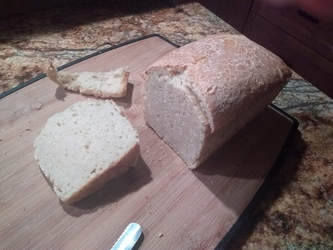
Now that school is out, I’ve got a little more time to play with historical recipes, and I’m back to making old fashioned breads. One I found curious, Salt-Rising Bread, appeared in my James Beard Cookbook, Beard on Bread. Beard called this recipe one of the oldest bread recipes in America, and included it as more of a curiosity than a successful bread. He warned that it could be temperamental and unreliable, but that just piqued my interest, so I had to do a little more research and then give it a try.
No one seems to know why this bread is called Salt-Rising. It does not taste salty, have an unusual amount of salt in it, and salt does not leaven the bread. One source suggested that early settlers kept the starter warm in a bed of heated salt. Another suggested that the salt inhibited yeast growth, allowing other leavenings to grow. I wonder if people just didn't know what leavened the bread, thinking it was the salt instead of bacteria from the potatoes.
To make a Salt-rising starter, place 1 1/2 cups hot water, 1 medium potato, peeled and sliced thin, 2 TBS cornmeal, 1 tsp sugar and 1/2 tsp salt into a 2 quart mixing bowl and cover with a lid. If you are going to do this the old fashioned way, place the jar in a bowl filled with boiling water and cover with quilts. A more modern way to do the same thing is to place the jar in an electric oven with the light on, or a gas oven with the pilot light on. Let stand for between 12 and 24 hours, until the starter has developed at least 1/2 inch of foam.
Add to the mixing bowl 1/4 tsp baking soda, 1/2 cup undiluted evaporated milk, 1 TBS melted butter, 1 tsp salt, and 2 cups of flour. Beat until very smooth. Continue adding up to 2 1/2 cups more flour, a cup at a time, until you have a soft dough.
Place a cup of flour on the counter. Turn your dough out of the bowl and knead it into the flour until the dough is smooth and soft. Shape into a loaf and place in a well buttered pan. Brush loaf with melted butter, cover with a piece of buttered (I use spray cooking oil) plastic wrap, and place in a warm, draft-free place to rise. I have a double oven, so I put it back into the oven with the light on. Rising may take as much as 4 or 5 hours.
Bake in a preheated oven at 375° for 35-45 minutes. Remove from pans to cool.
The resulting loaf had a very fine texture, but the top crust pulled away from the loaf. It had a slightly tangy taste to it, and was excellent with butter and toasted. It reminded me more of beer batter bread than traditional yeast bread, but I think it would be a good breakfast bread, and an excellent accompaniment to a hearty stew.
Jennifer Bohnhoff has written two novels set in the Civil War: The Bent Reed and Valverde. You can read more about all her novels here.

